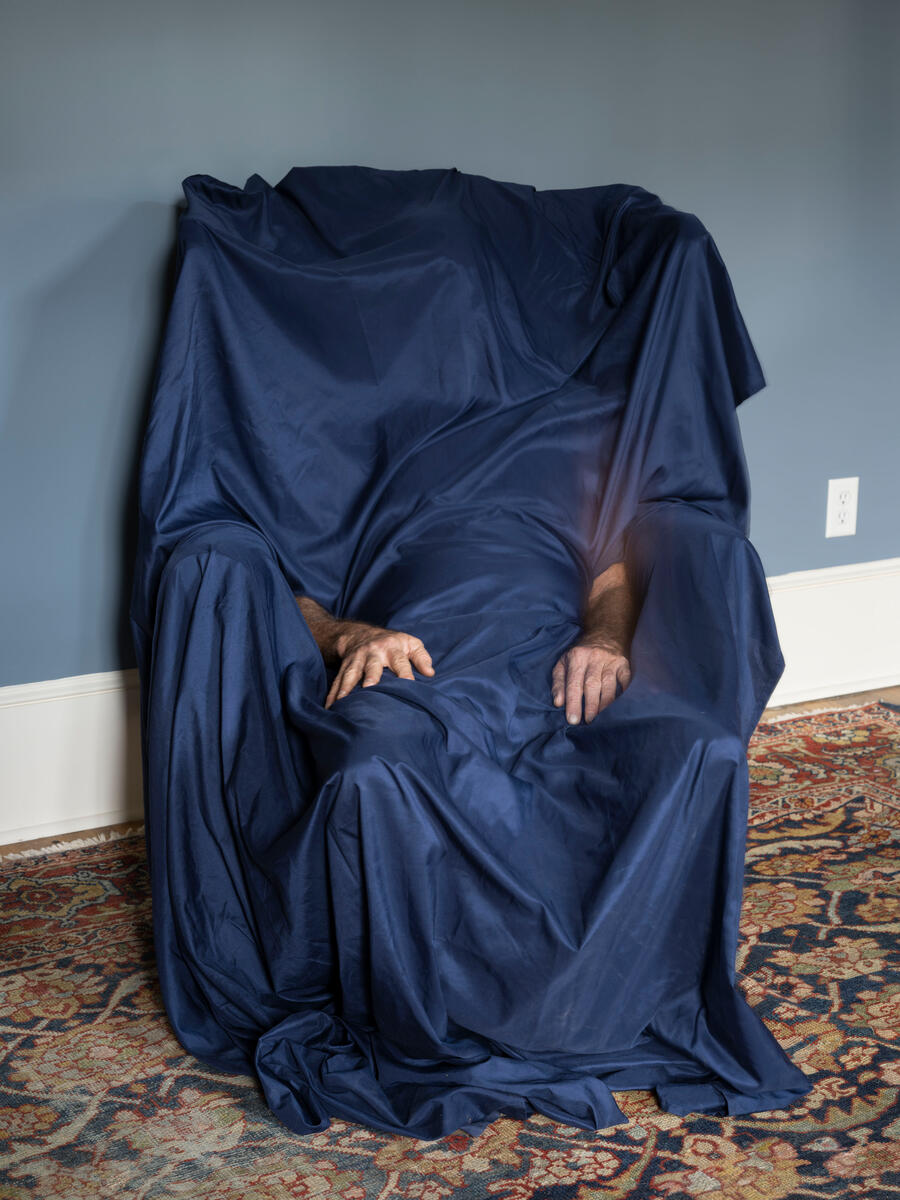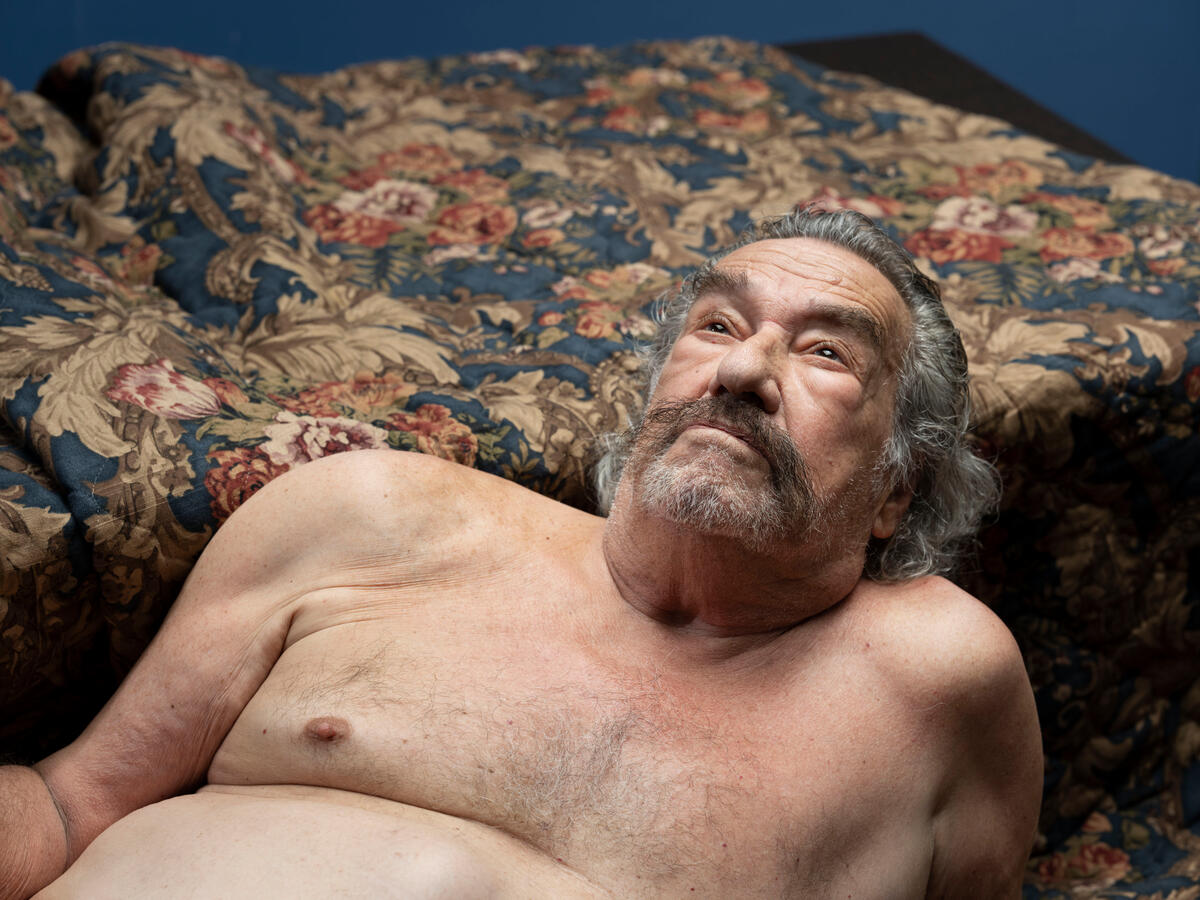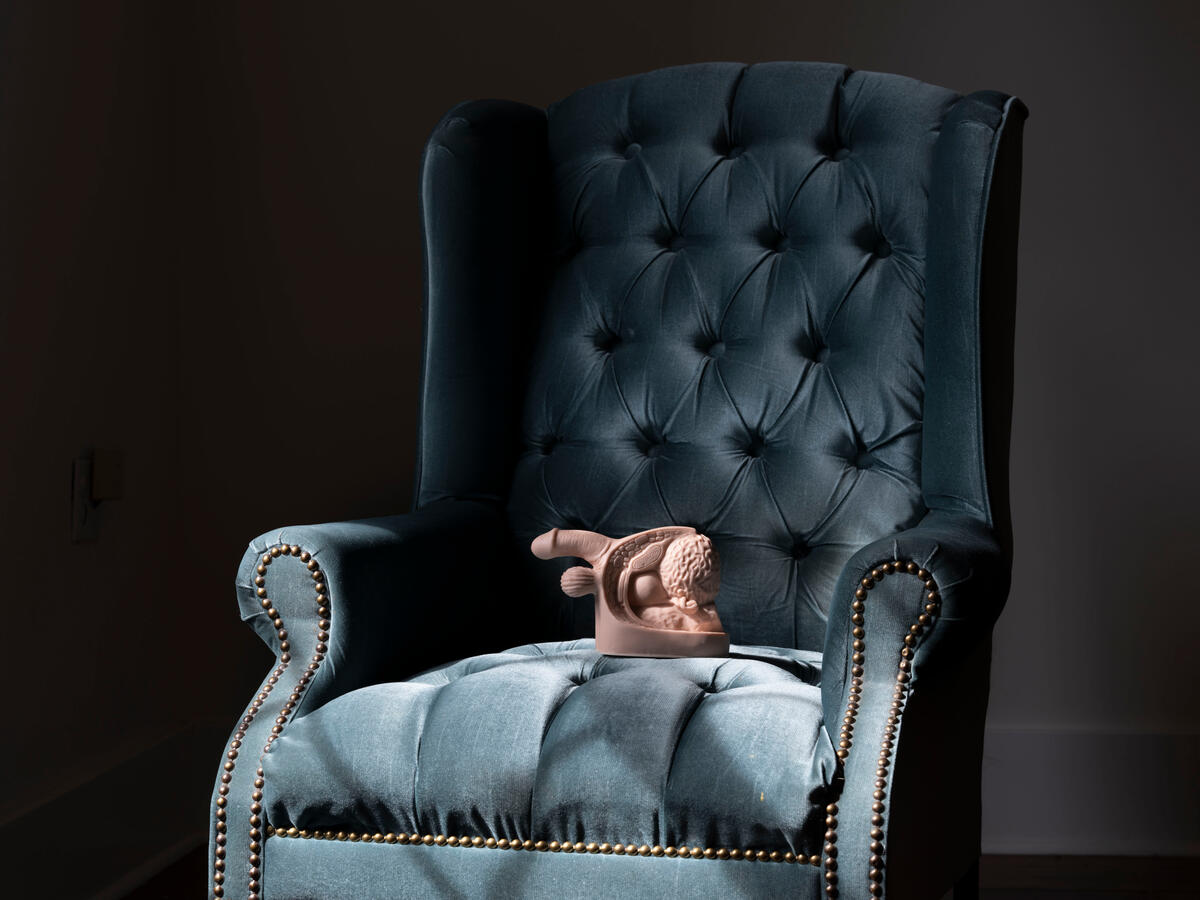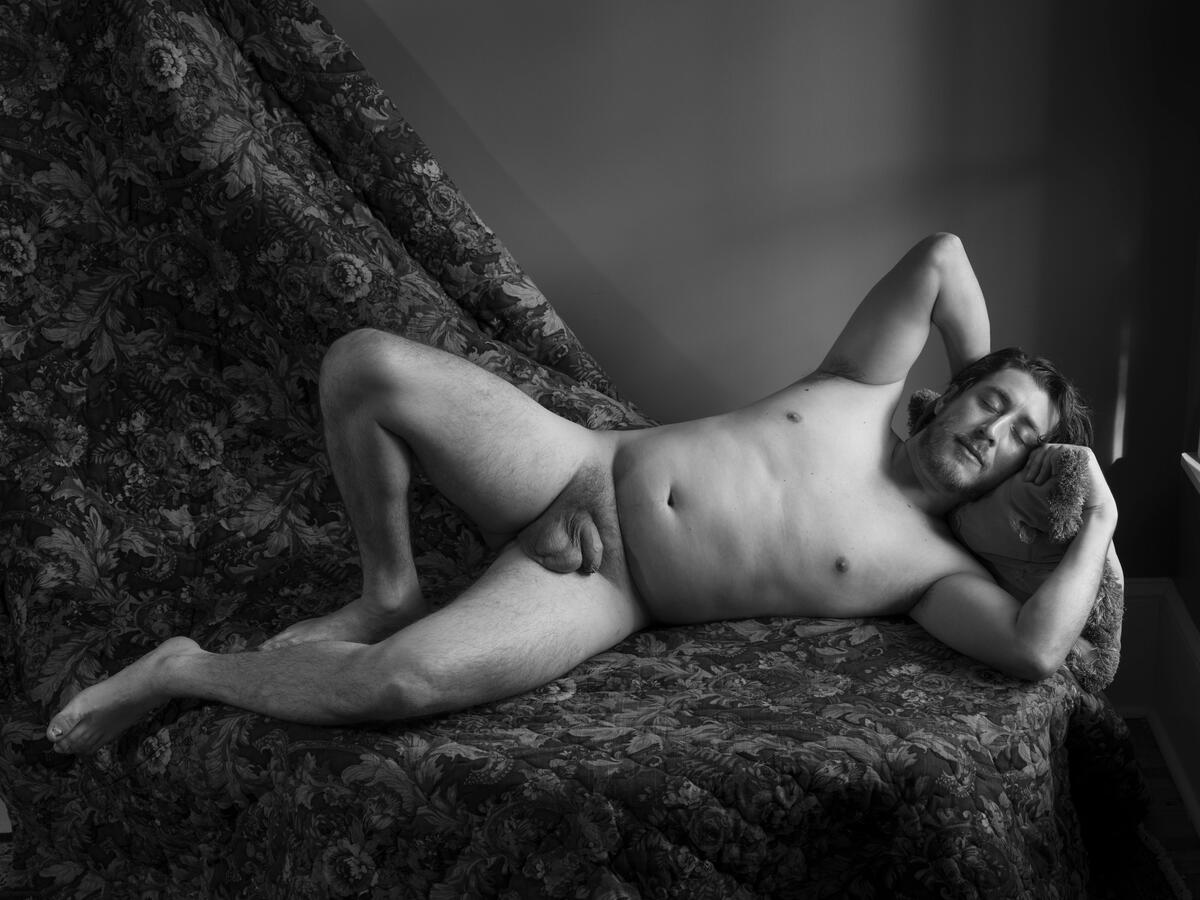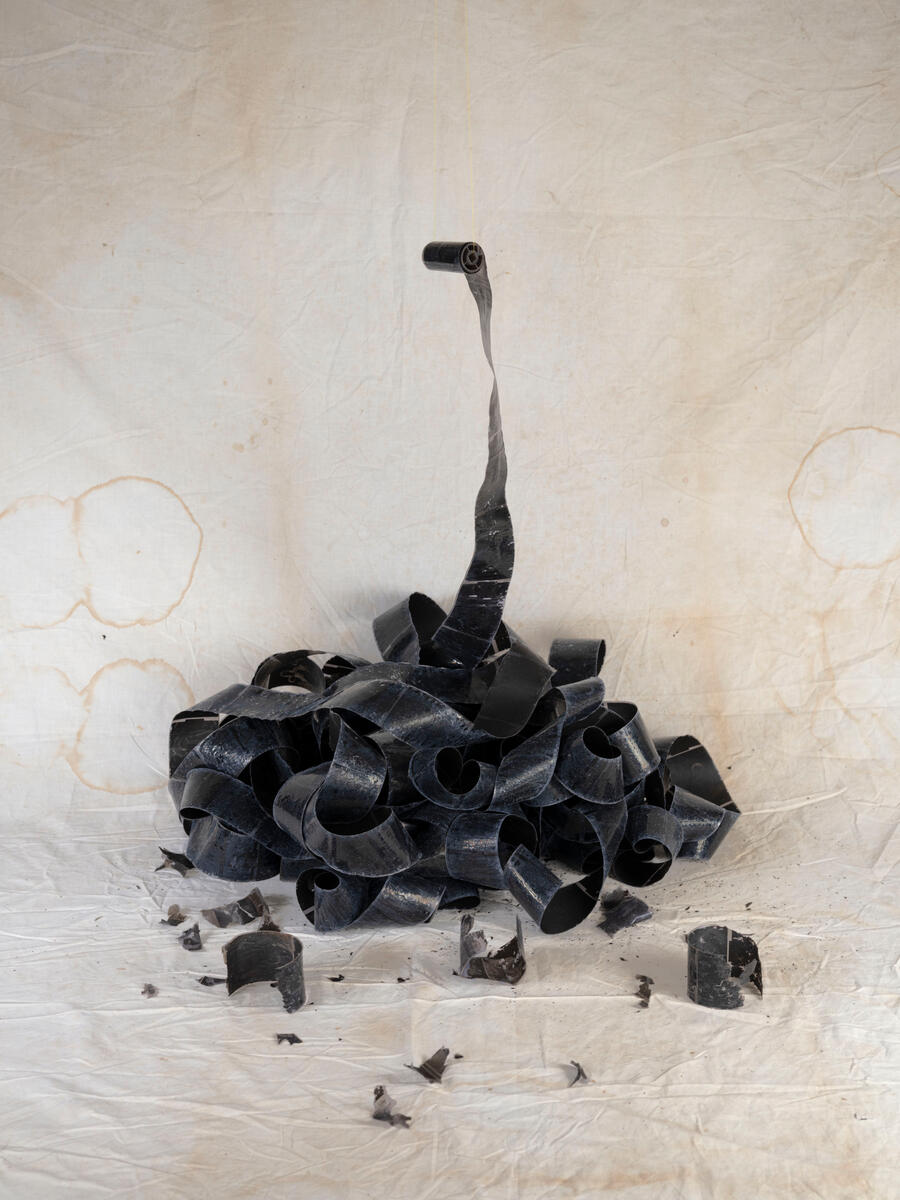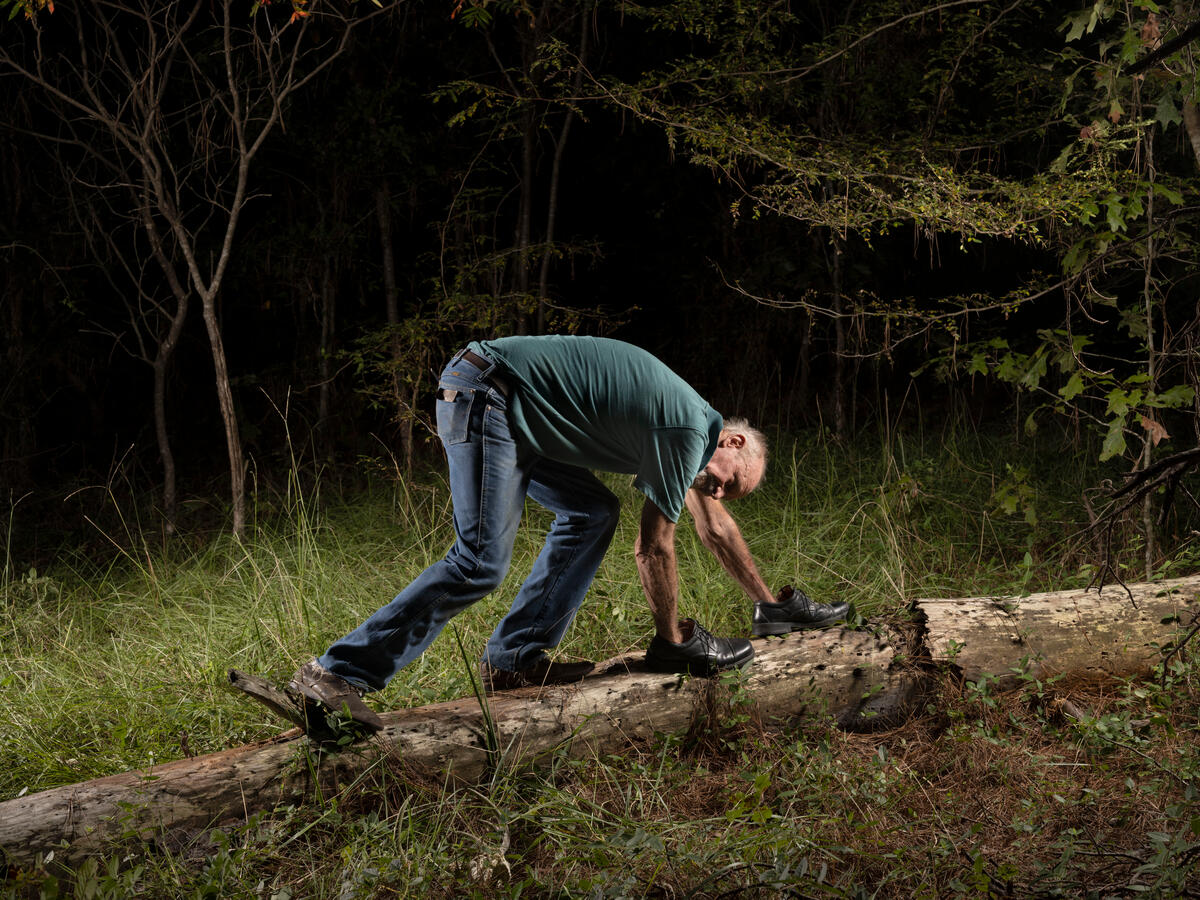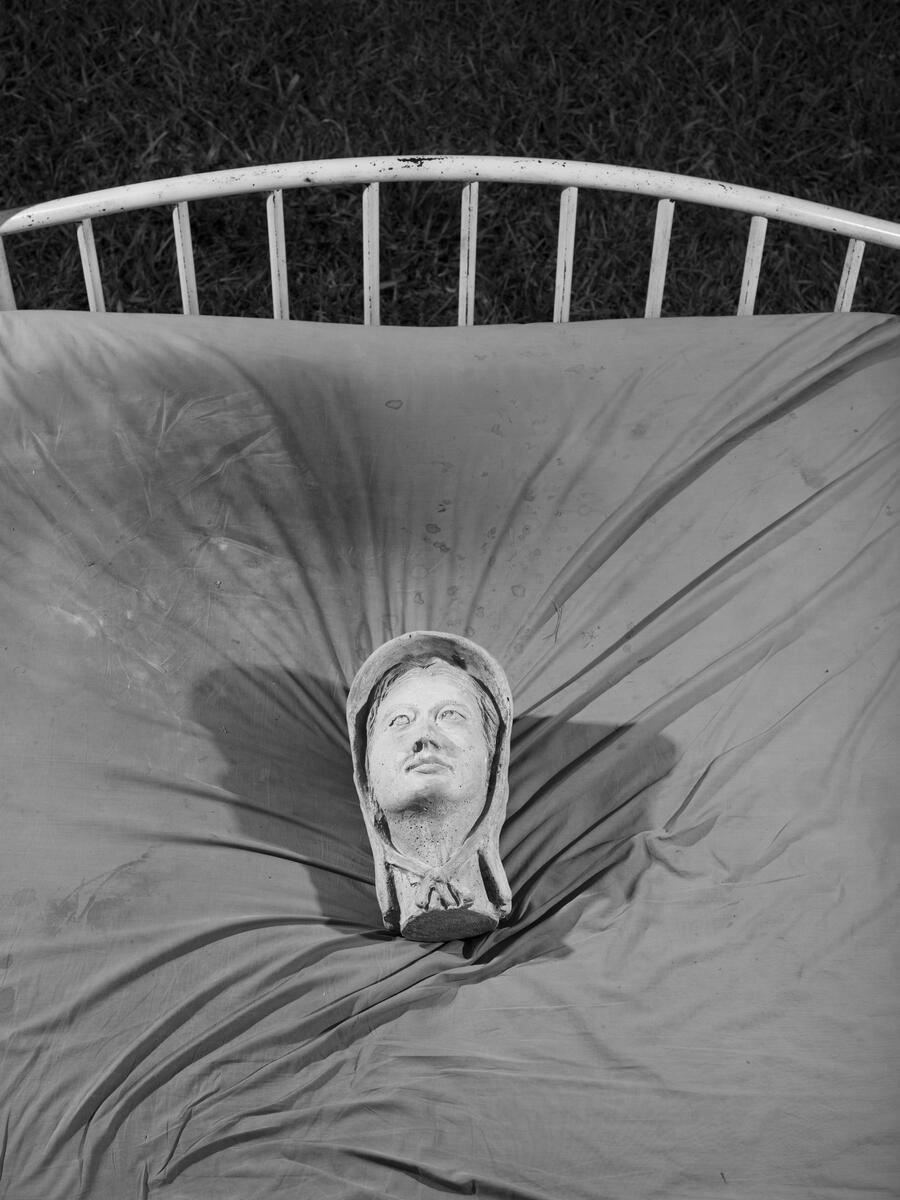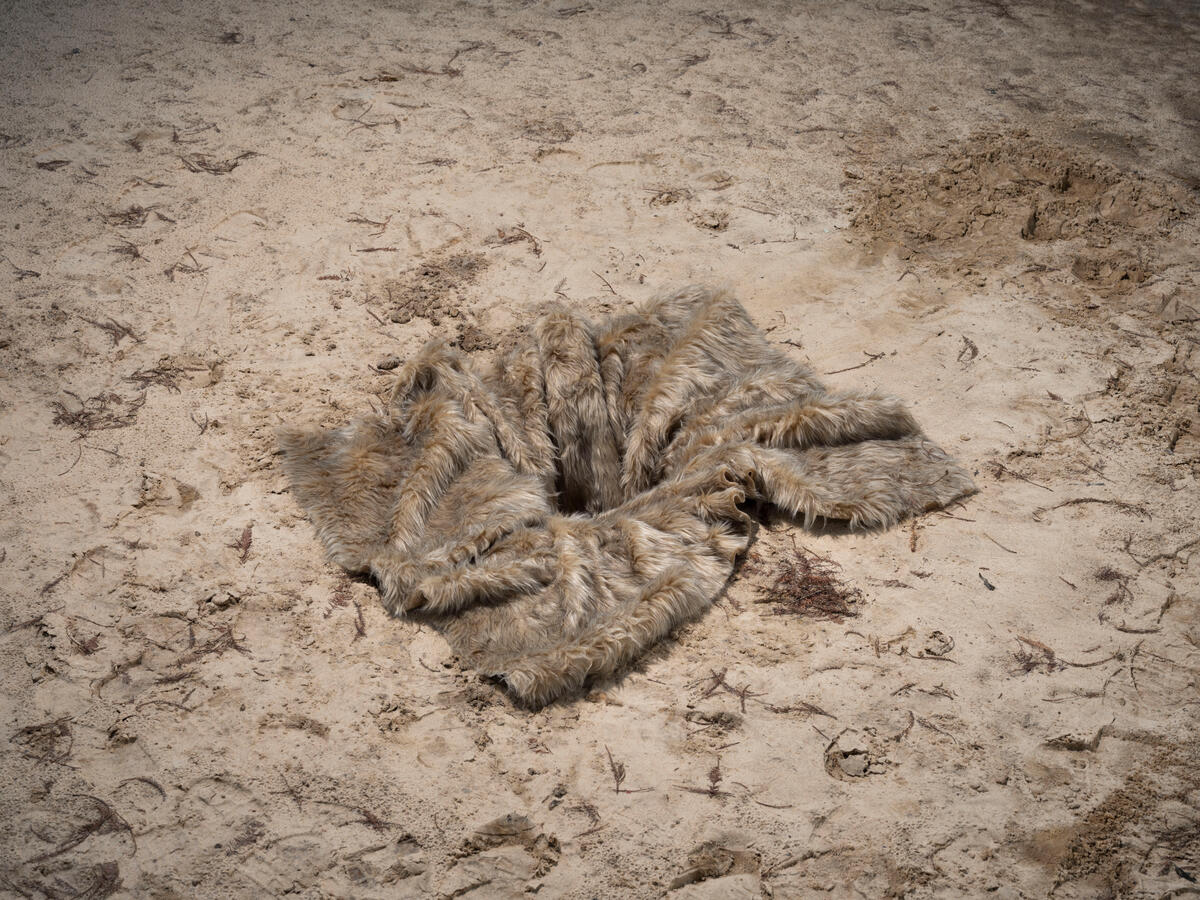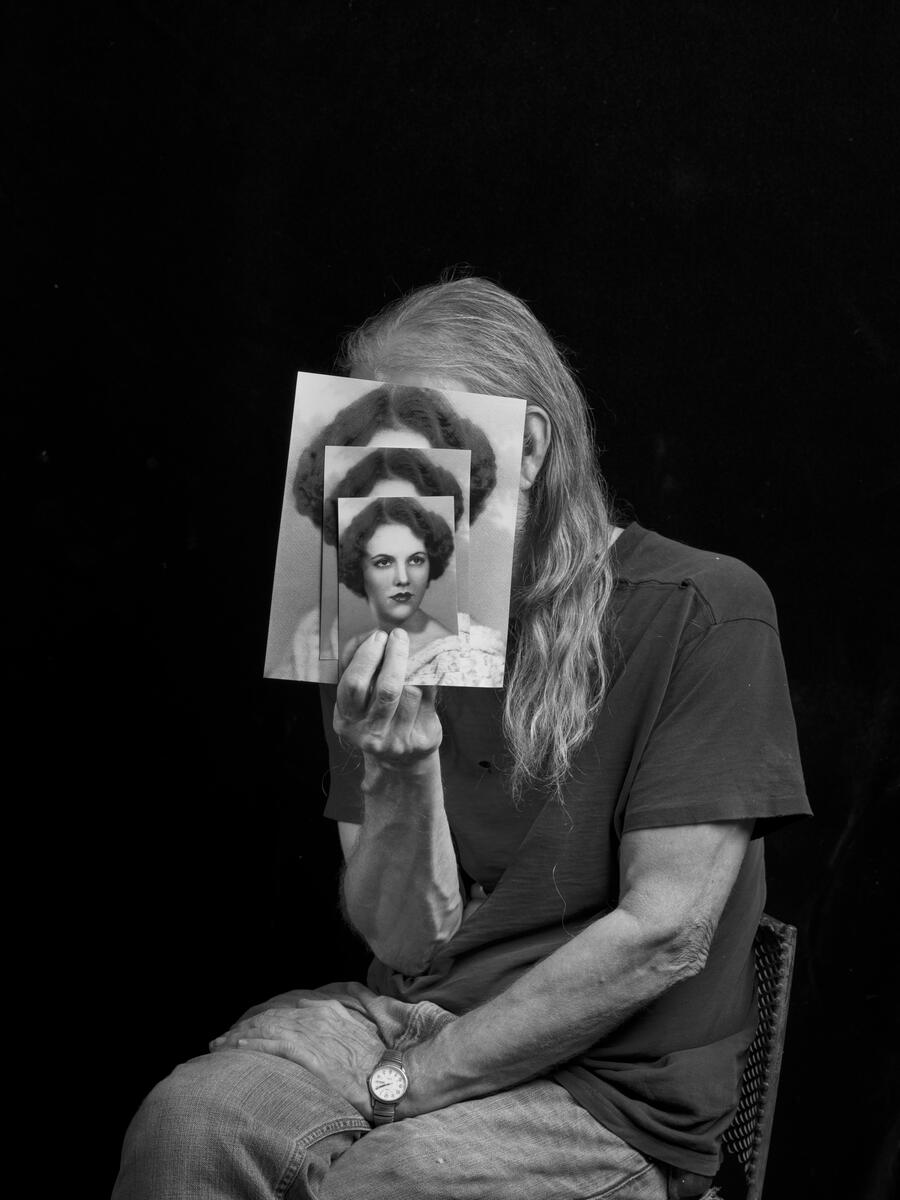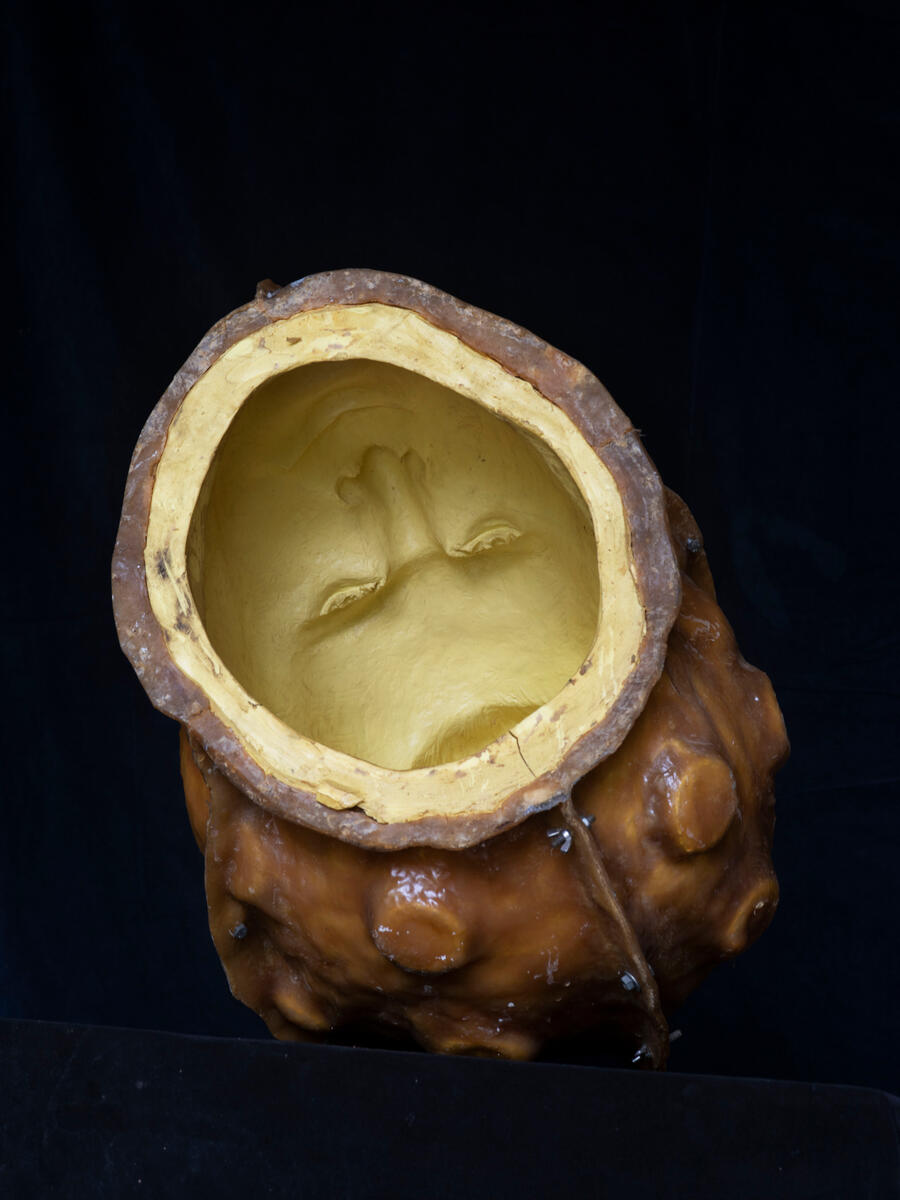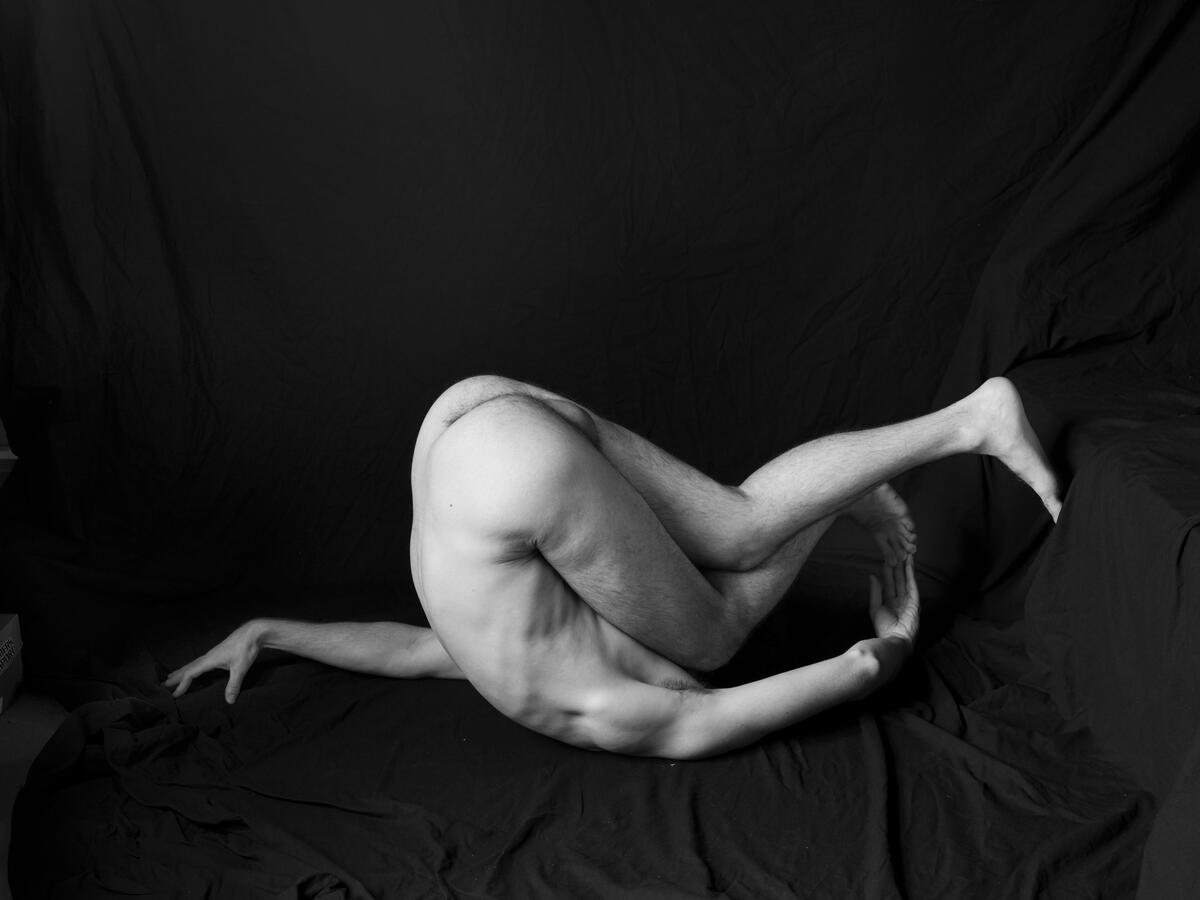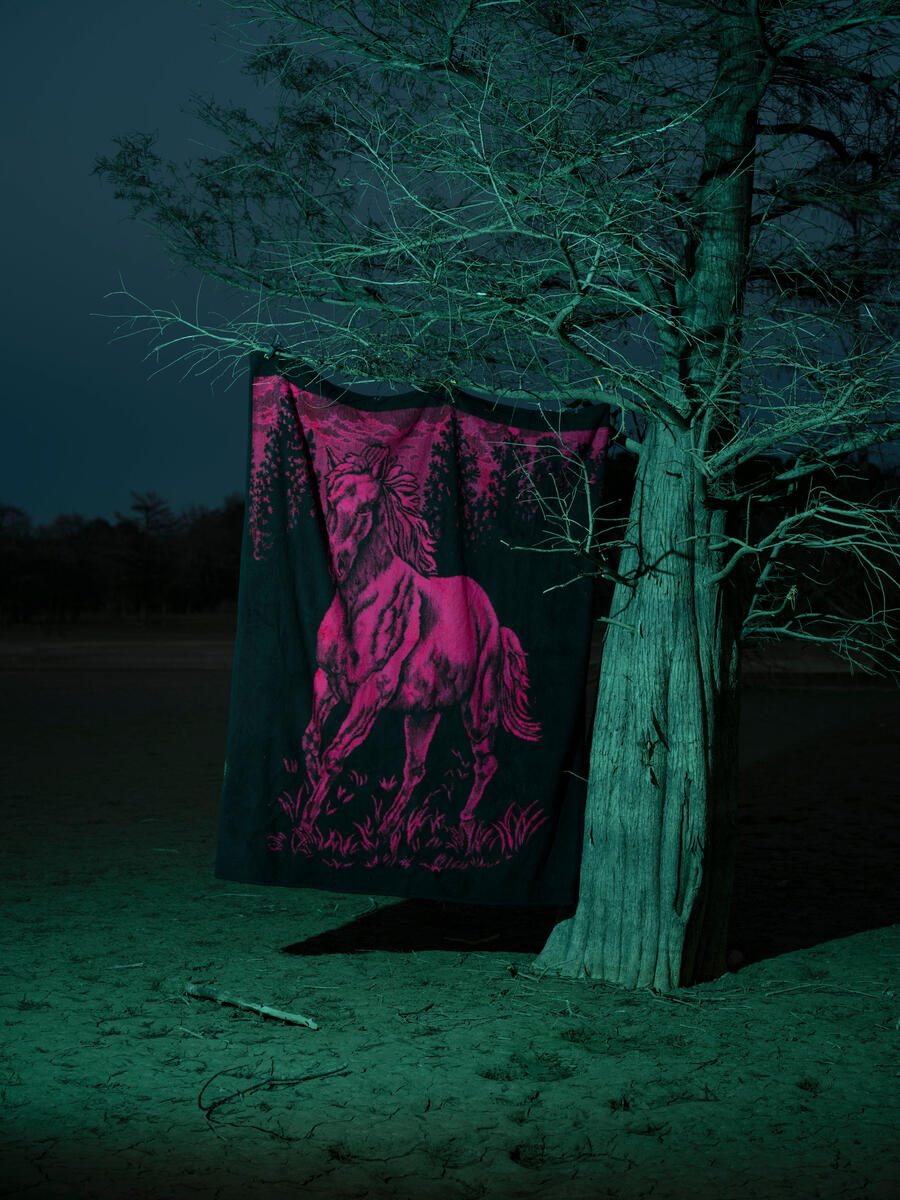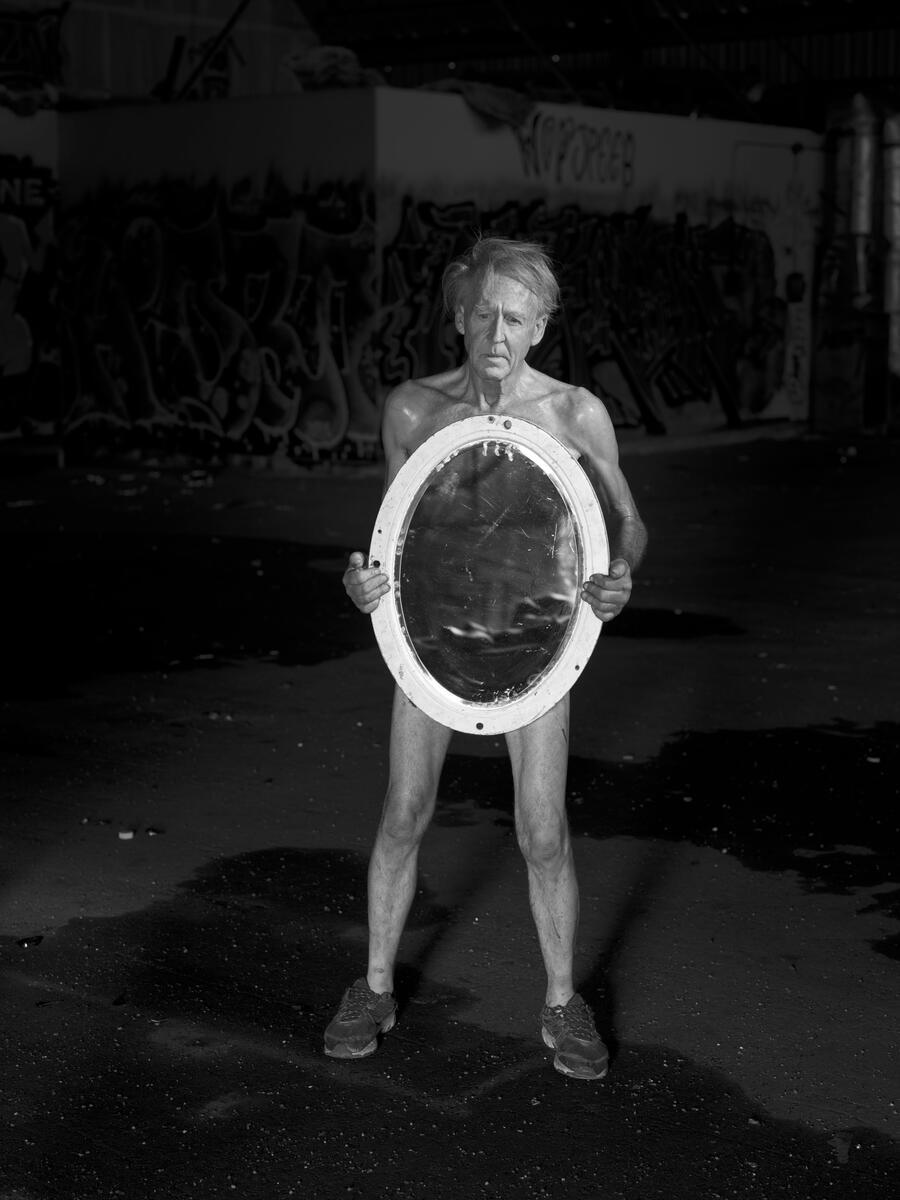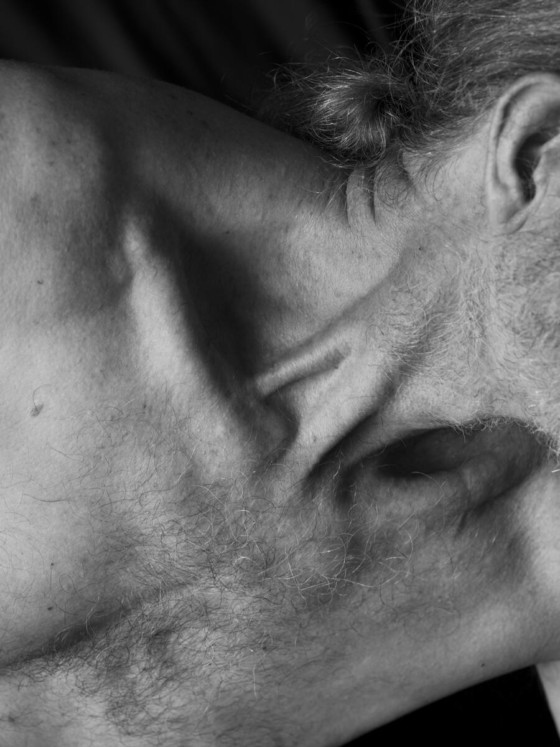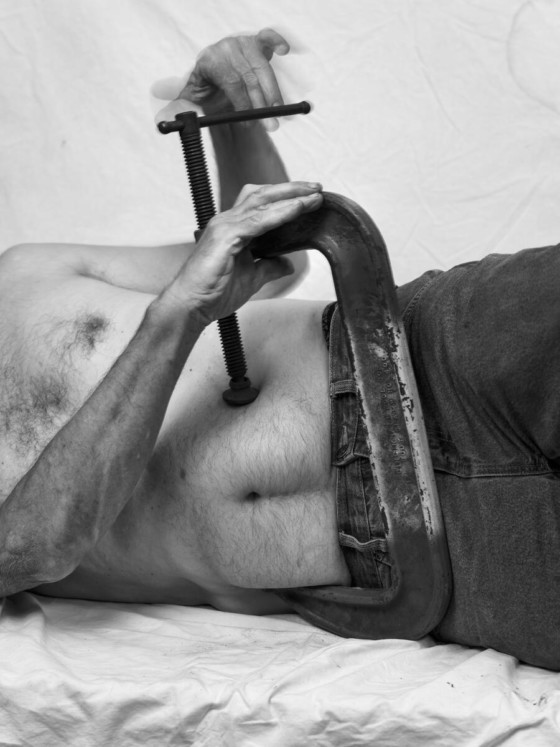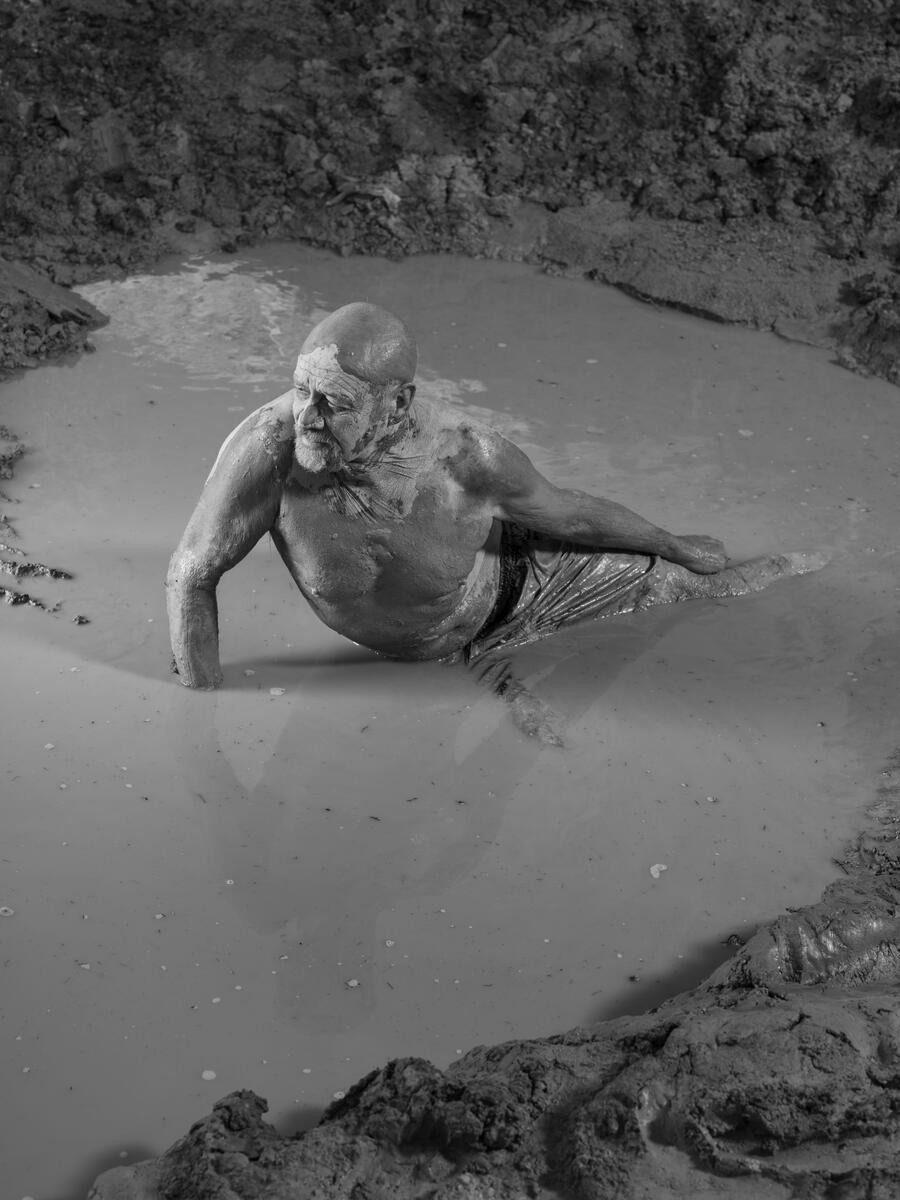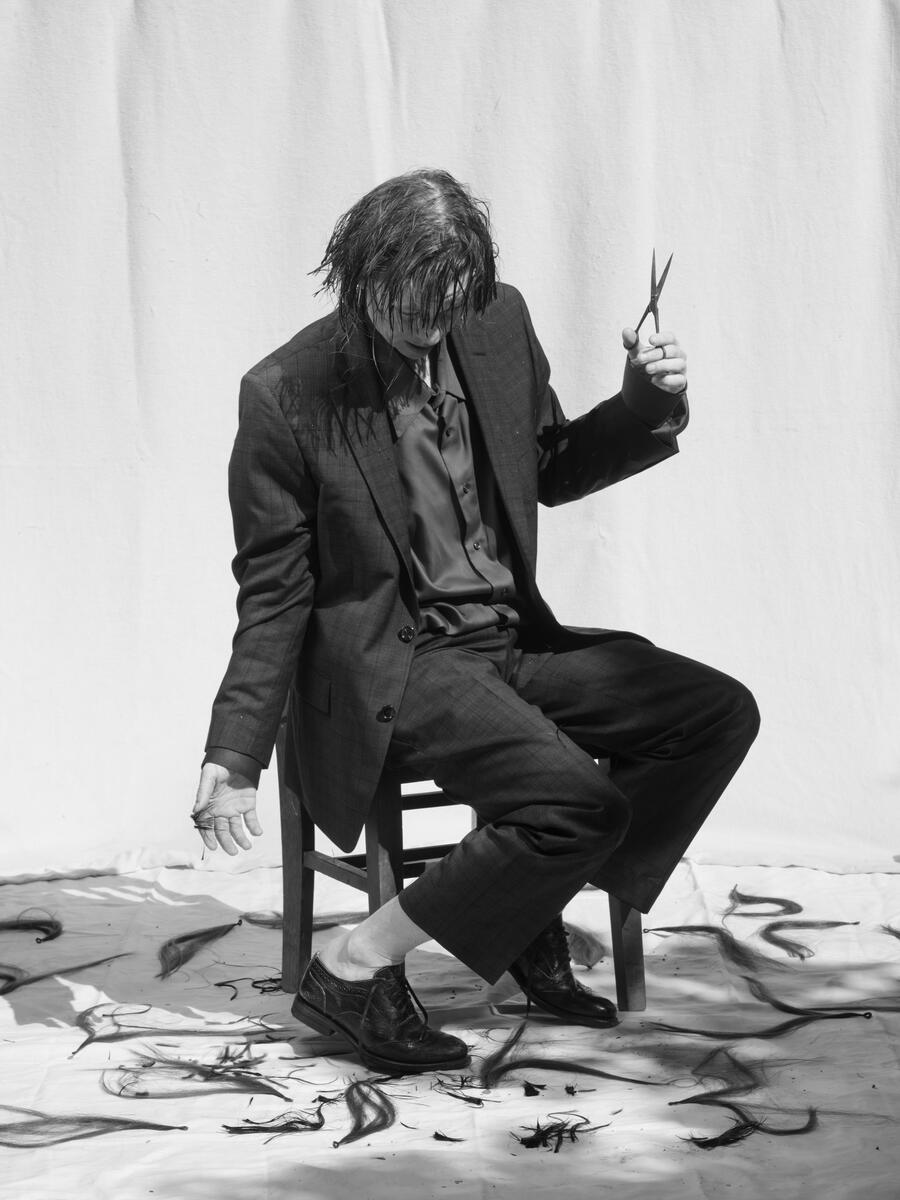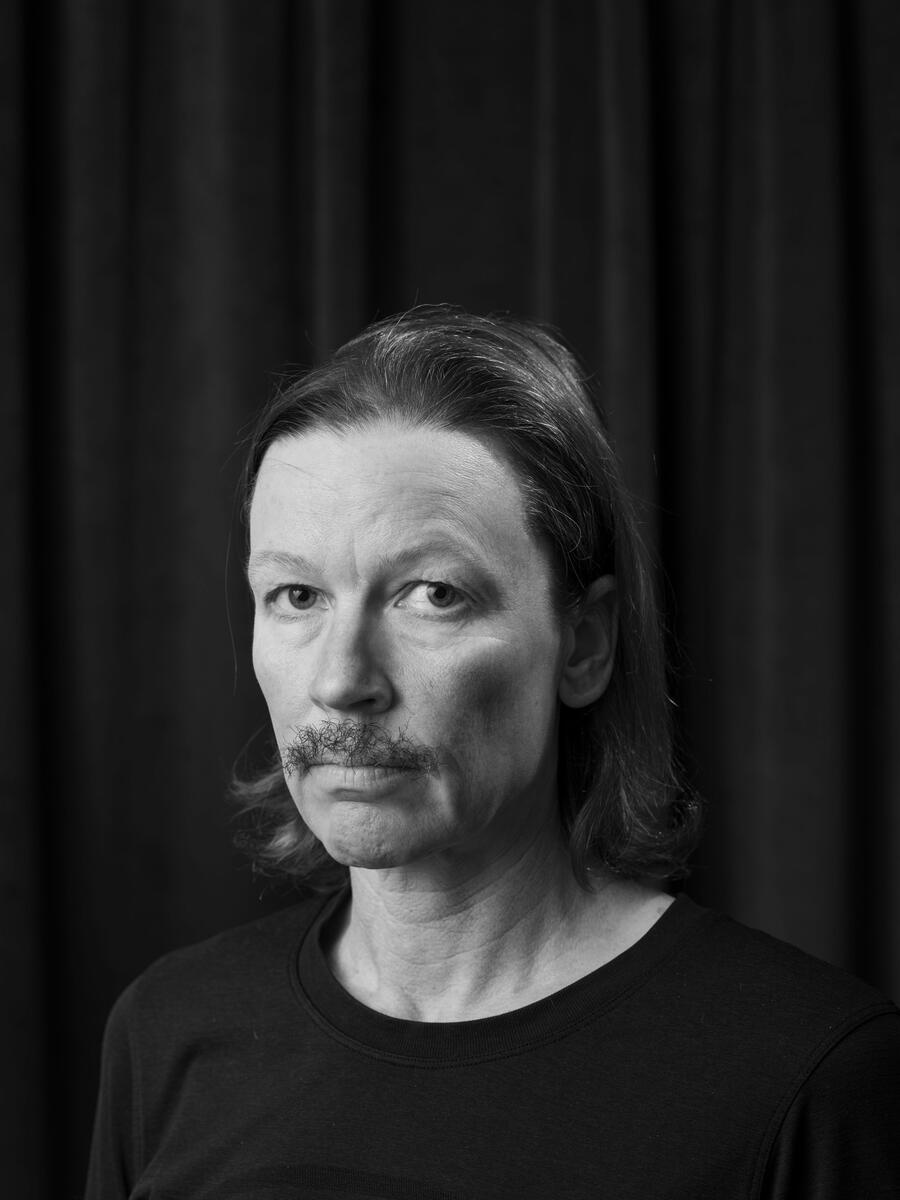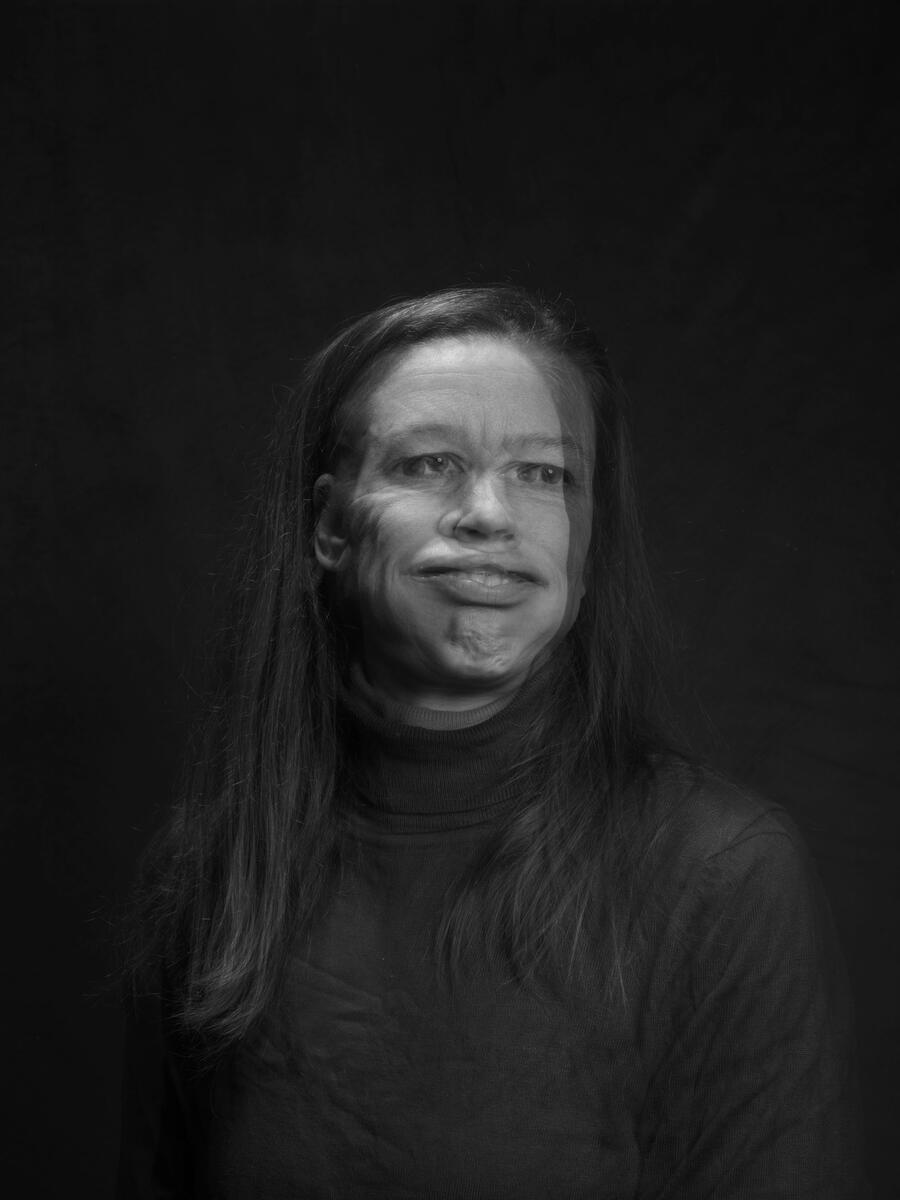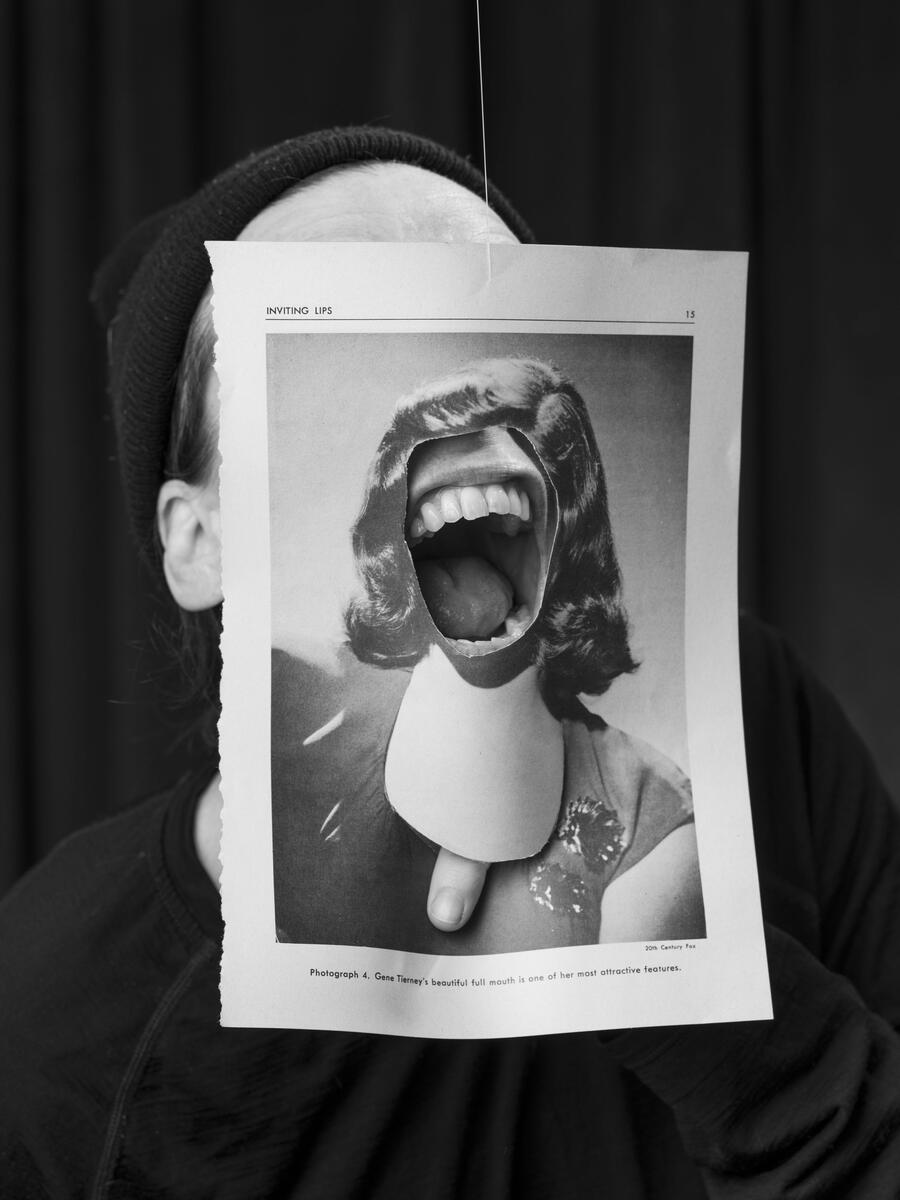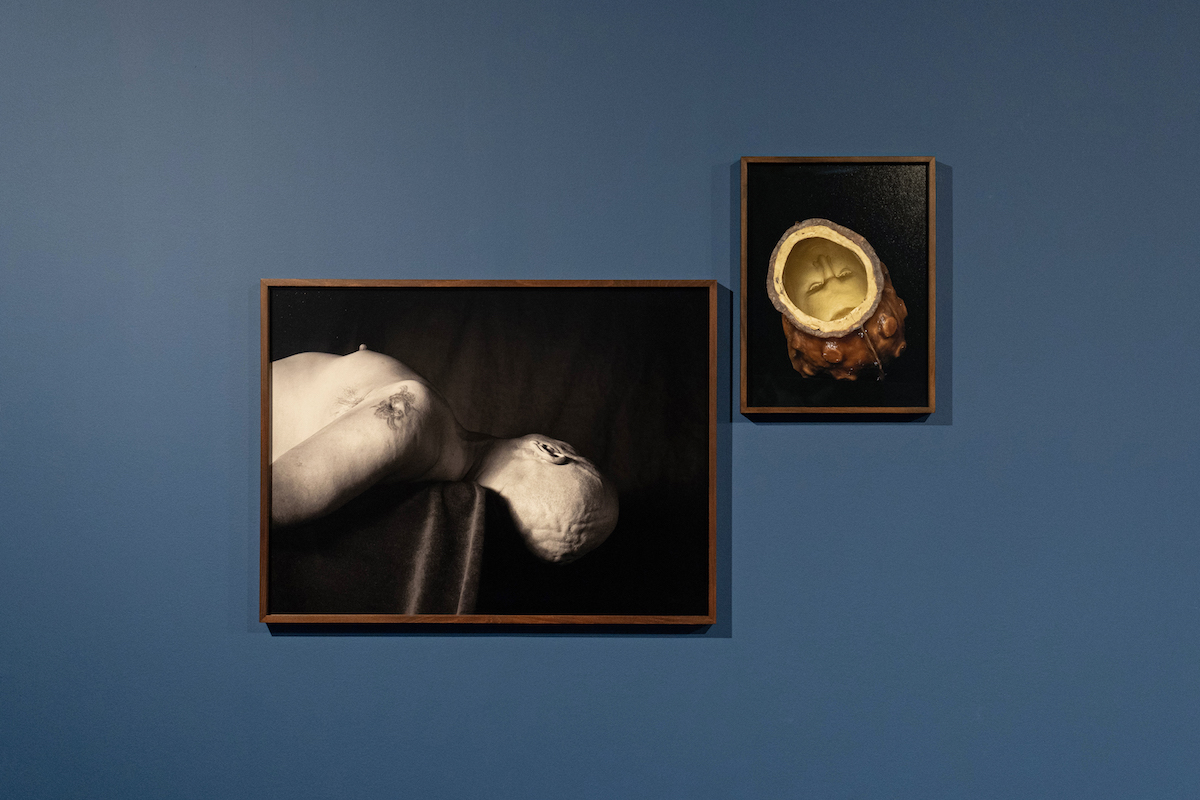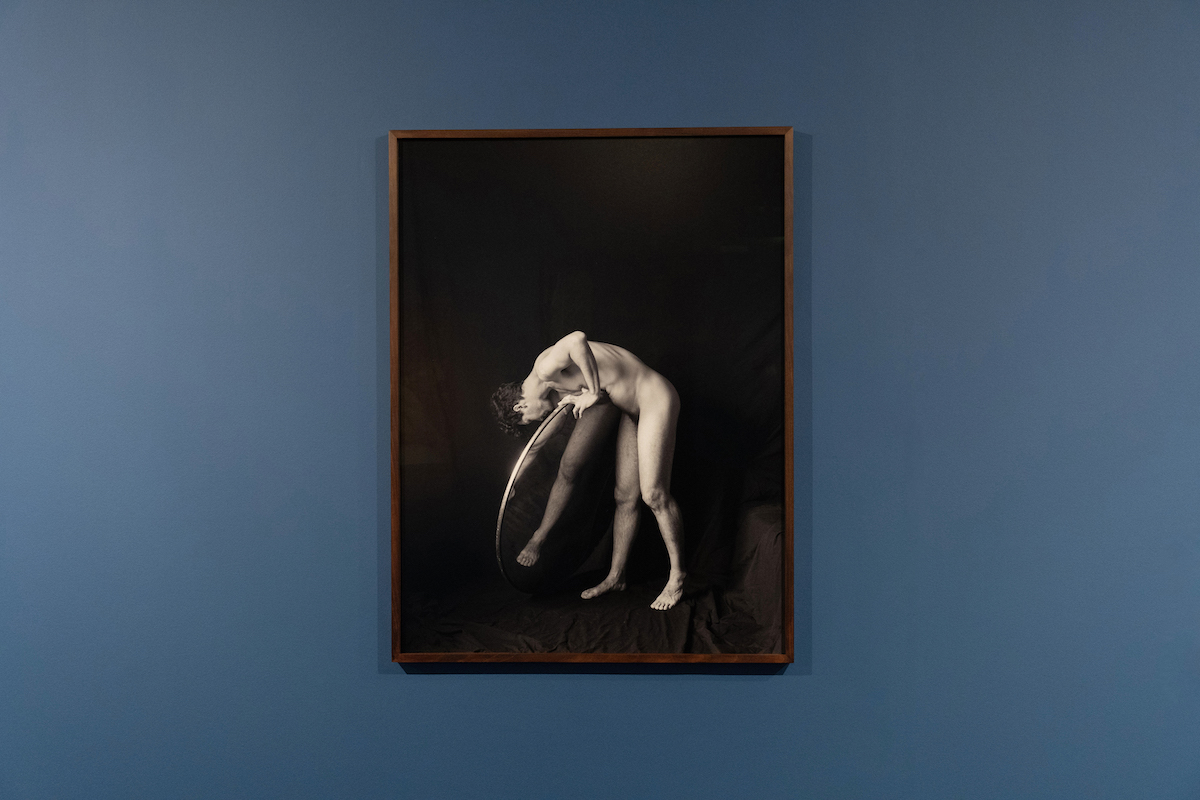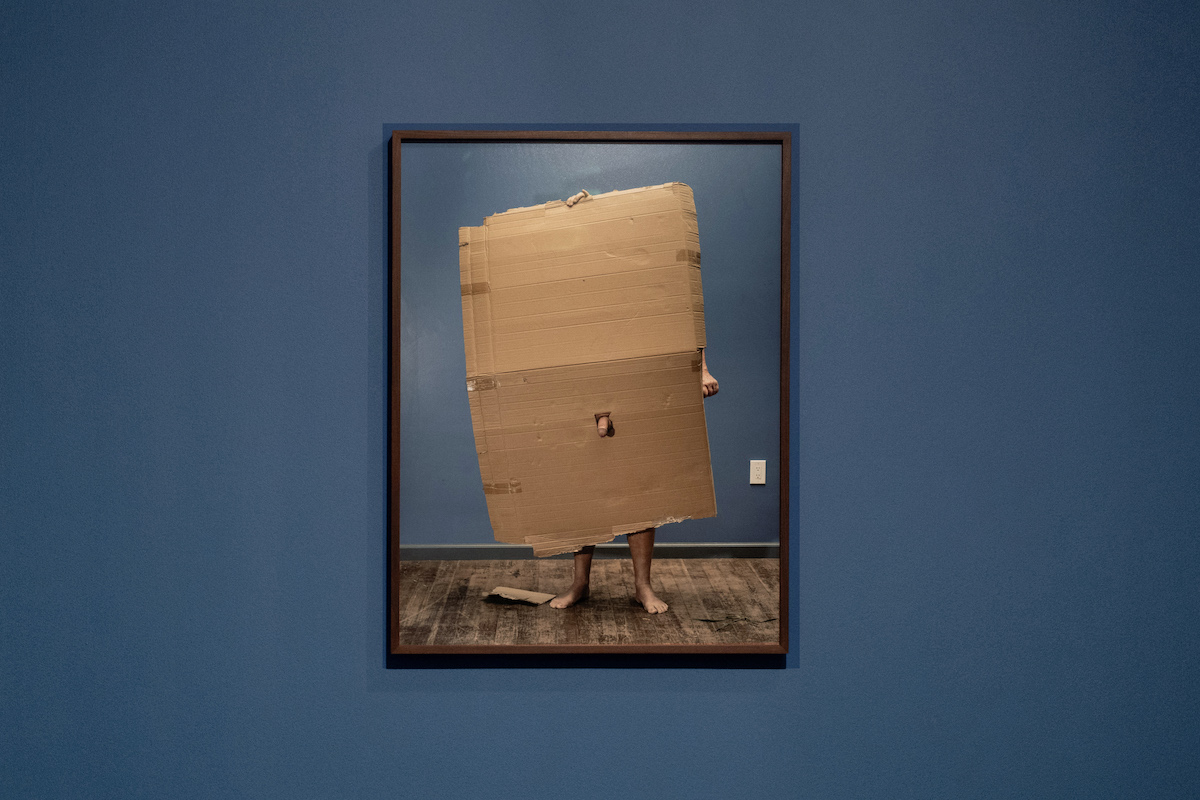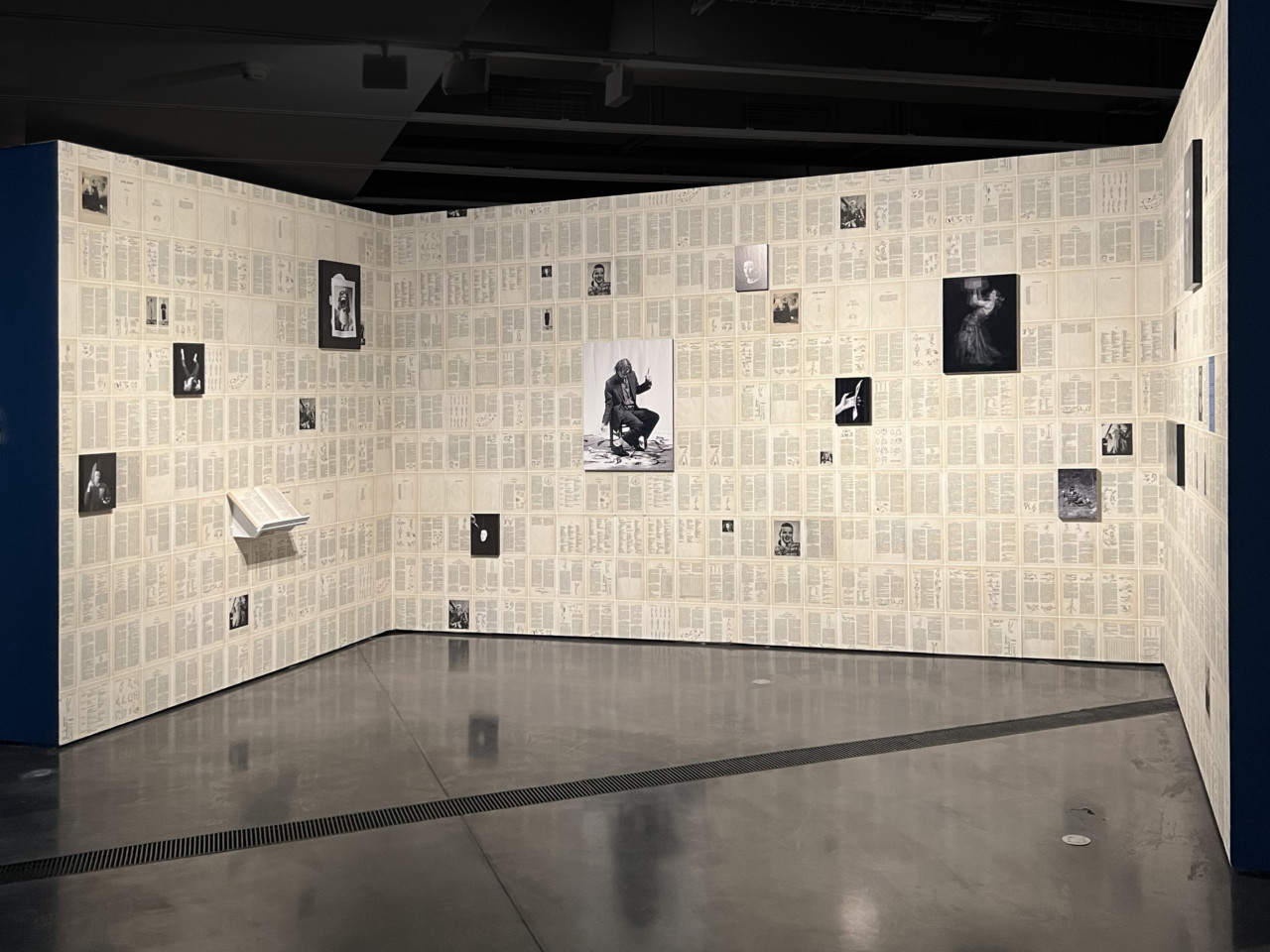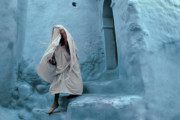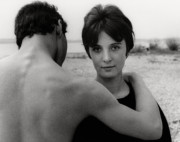Carolyn Drake Interrogates Myths of Men and Masculinity
The photographer’s new body of work, “Men Untitled,” is currently a major exhibition at the Fondation Henri Cartier-Bresson in Paris.
As soon as you enter the exhibition space for Carolyn Drake’s latest solo show at the Fondation Henri Cartier-Bresson in Paris, you are immediately confronted by the prominent blue walls. A striking portrait of an anonymous figure draped in a royal navy blue cloth hangs from the wall directly in your line of vision, with only the subject’s hands peeking through. Next to it are the words, in bold, “Men Untitled.”
In the 19th century, when mothers went to a photography studio to have their children photographed, they had to find a way of keeping the child calm and collected through the long exposure times necessary for early photography. They would typically hold the child, but cover themselves completely with cloth throughout the process, keeping them hidden away — invisible and anonymous. “I was exploring the idea of putting men in the positions that women were traditionally put in,” explains Carolyn Drake of this opening image in a talk organized by the Fondation HCB in September.
Two years ago, Drake became the recipient of the 2021 HCB Award — an award granted every two years to support an ambitious photography project. The year before, in 2020, the photographer had published Knit Club, a project in which she photographs a community of women in the small town of Water Valley, Mississippi. And Men Untitled acts as its sequel, shifting the photographer’s gaze from women to men. “I felt like I had situated myself in a specific genre of women photographers making projects about women,” she explains. “But there didn’t seem to be many women directing their gaze to men and masculinity, and I felt like that was a vacuum that I wanted to explore.”
"The truth is, the male body is not a subject that I’ve ever been encouraged to scrutinize the way we do women’s bodies. It’s as though the act of looking at men is inherently dangerous. "
-
In the summer of 2021, Drake traveled back to Water Valley, keen to re-immerse herself in the community. She started by photographing some of the men who had been involved in Knit Club, or the husbands of the women that had featured in the project. Shoots were experimentative at first, with Drake testing the waters and exploring different ways of portraying, or defying, conventional ways of perceiving “masculinity.” And slowly, but surely, the project evolved. It took time for her to feel comfortable asking men to take their clothes off, and even to realize that it was what she wanted to ask of them. And, what originally started as an exploration of masculinity in one specific place expanded into something that transcended geographical boundaries, as Drake moved back to California and continued to shoot there.
She describes her approach now as a sort of “voyeurism reversed,” an act of interrogating the ways in which women and their bodies have been represented in art history, and the history of photography, and then flipping the perspective. A large proportion of the men that appear on walls of the exhibition, and in the pages of the book, are visibly older. “I think I was interested in the longer histories that are visible in the bodies of older men,” she explains. “Older men also seemed to be more vulnerable, on the inside and outside.” And whilst several of the poses themselves, such as a figure lounging stark naked on a makeshift divan, seem all too familiar, there is an undeniable novelty to the fact that these are portraits of men.
Walking around the exhibition, we encounter a multi-faceted exploration of maleness. Intimate images of men, their bodies in varying degrees of nudity, are joined on the walls by images of objects, rich in symbolism, and often tweaking or subverting stereotypical representations of masculinity. In one, a blanket decorated with the image of a striking pink stallion hangs from a tree illuminated in a surreal green light. “I wanted to surprise the viewer,” Drake explains. “I don’t want to deliver what you expect to see when you look at masculinity.”
Many of the images, if not all, have hidden backstories or references. To the right of the ‘hidden mother’ portrait at the entrance of the exhibition is a diptych of a half-naked man sitting cross-legged on the floor with his back to the camera. He holds up a chair to one side, and then the other, the muscles in his upper back protruding on each side to show the effort of the movement.
The sequence, to Drake, was reminiscent of Eadweard Muybridge’s 19th century motion sequences. “I was interested in how his motion sequences portrayed gendered performances as though they are scientific facts…” she explains to the crowd at the Fondation HCB as she reveals the stories behind the images. “He instructs his nude subjects to interact with props. For example, he’ll give two women glass vases and ask them to pour water on each other, and then he’ll give two men swords and ask them to fight. I found it disturbing and it made me want to make my own version of these motion studies.”
In another image, we see a surreal image of a foot, dislocated from its body, appearing through a sculpture mold as though striving to step out. For Drake, placing the body in this context is a reminder that gender identity is something that is constantly being molded — a heavily constructed illusion that as a society, we continue to craft day in, day out.
The exhibition was curated by Clément Cheroux, former Chief Curator of Photography at MoMA in New York City, and now Director of the Fondation Henri Cartier-Bresson in Paris. “When we talk about relationships between men and women, there is a very great dialectical power in her,” he tells Fisheye. “When we look at her images, there is both anger and empathy. You can feel one thing and its opposite at the same time.”
“I was starting to go through hormonal changes that were affecting how I experienced my own identity as a woman, or my own experience of gender,” Drake explains in an introduction to the exhibition. “My sexuality was changing and there was a lot going on in American politics that was making me angry — enacting laws against abortion, very misogynistic politicians — and feeling very powerless against those things that were happening. So there was a certain amount of anger at men in general, or at patriarchy, or misogyny, that I allowed myself to bring into the work.”
And yet despite the project being initially fueled by anger, Drake also speaks of the empathy that was developed through the experience of shooting the project, and through the playfulness of her experimentative, collaborative approach with her subjects. The men exposed are friends, neighbors, and acquaintances from her life. There is a richness to the stories that she shares of the shoots, of the relationships built, and of the stories exchanged. The result is an intimate exploration of myth and masculinity, carved playfully from her imagination and the vulnerability that these men offered.
"That tension between empathy and anger plays into a lot of the work, I think."
-
Walking around the exhibition, as you reach the back of the space, you find an entrance to a smaller enclave in the very middle, which forms the hidden core of the exhibition. Here, we are immersed in a different project, titled Glorify Yourself. The project delves into a “beauty and charm guide” for women, popular in the U.S. during the 1940s and 50s (although the latest edition was published in 2018 and still sells on certain ecommerce sites for $25). Its pages, with chapter names like “Inviting Lips” and “Sitting Technique,” are plastered across the walls, full of advice for its female readers on how to best serve their men and satisfy beauty standards in seemingly all aspects of their lives, from how to diet to change their body type to how to sit, or walk, in a ‘graceful’ and ‘attractive’ manner.
“The book provides insight into the universe of desires and delusions that gave rise to the world I inhabit,” Drake has written on one of the walls. “With a mixture of satire and scorn, I began putting myself in the positions described in the book, exploring my relationship to its creed.” Layered over the pages of the book is a series of atypical self-portraits shot by Drake. In one, a page has been ripped out from the book, with the text reading “Gene Tierney’s beautiful full mouth is one of her most attractive features.” The face of the woman has been cut out and in its place, we see Drake’s own mouth, wide open, as if screaming.
To a contemporary audience, the extracts from the book scattered over the walls seem farcical — a shocking reminder of the extent to which women’s bodies have been picked apart, dissected, and stubbornly shaped over centuries in order to maintain stereotypical gender roles and please the male gaze. In the exhibition, the parenthesis of what Drake describes as her “inner world” acts in dialogue with the intimate photographs of men scattered around the perimeter, adding a whole new layer to the experience.
The next chapter for Drake, alongside continuing to explore the series Glorify Yourself, is a collaborative project set along the US-Mexico border, made with her partner and fellow visual artist Andres Gonzalez. Titled I’ll let you be in my dreams if I can be in yours, the project is set to be published next September by MACK.
Men Untitled runs at the Fondation Henri Cartier-Bresson in Paris until January 14, 2024.
Signed copies of the book, published by TBW Books, are also available in the Magnum Shop.
Thank you to the Fondation Henri Cartier-Bresson for the talks organized with Carolyn Drake around the book and exhibition. Click here to view the full video, titled “Le Feuilletage.”


